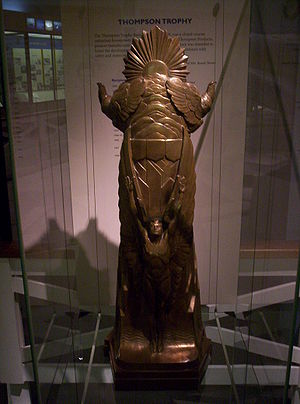
Thompson trophy
Encyclopedia

National Air Races
The National Air Races were a series of pylon and cross-country races that took place in the United States from 1920 to 1949. The science of aviation, and the speed and reliability of aircraft and engines grew rapidly during this period; the National Air Races were both a proving ground and...
of the heyday of early airplane racing in the 1930s. Established in 1929, the last race was held in 1961. The race was 10 miles (16.1 km) long with 50 feet (15.2 m) pylons marking the turns, and emphasized low altitude flying and maneuverability at high speeds. As the race was flown around a closed course, crowds in the grandstands could easily see much of the spectacle.
There were two series of Thompson races. The first series followed the award of a "Thompson Cup" in the 1929 National Air Races to the winner of the "International Land Plane Free-For-All" (that is, the unlimited class race). Thompson Products (a predecessor to TRW
TRW
TRW Inc. was an American corporation involved in a variety of businesses, mainly aerospace, automotive, and credit reporting. It was a pioneer in multiple fields including electronic components, integrated circuits, computers, software and systems engineering. TRW built many spacecraft,...
) decided to sponsor a trophy to be awarded for the next ten years for unlimited class racing (though a stipulation was eventually added excluding women pilots). The trophy was designed by Walter Sinz
Walter Sinz
Walter A. Sinz was an American sculptor. His best known work was the Thompson Trophy. He was educated at the Cleveland School of Art, where he also taught from 1911 to 1952. In addition to his bronze and medal work, he designed figures for Cowan Pottery.-References:* from the Cleveland Museum of Art...
and is now at Air and Space Museum. Sinz also made a pair of 10 feet (3 m) models of the trophy for promotional purposes. Races were held for the next ten years, ending in 1939. Further races in this series were precluded by the onset of war.
After World War II
World War II
World War II, or the Second World War , was a global conflict lasting from 1939 to 1945, involving most of the world's nations—including all of the great powers—eventually forming two opposing military alliances: the Allies and the Axis...
the original trophy was (according to stipulation) retired. Also, advances in airplane technology, especially the advent of the turbojet, complicated matters. It was decided to establish a new series, with "R" (piston engine) and "J" (jet-powered) divisions. The "R" class was for civilian competition; the "J" division was for military pilots and was administered by the United States Air Force
United States Air Force
The United States Air Force is the aerial warfare service branch of the United States Armed Forces and one of the American uniformed services. Initially part of the United States Army, the USAF was formed as a separate branch of the military on September 18, 1947 under the National Security Act of...
. Roscoe Turner
Roscoe Turner
Roscoe Turner was an aviator who was a three time winner of the Thompson Trophy.-Background:Turner was born in Corinth, Mississippi, the eldest son of a poor but respectable farmer. He came to realize that he did not want to be a farmer and found that he was attracted to mechanical devices instead...
, the last winner of the pre-war trophy, refused to relinquish it, but the original molds were located, and two additional casts were made, differing only in the legend engraved at the base and by placards identifying the division. Division "R" races were held from 1946 to 1949; Division "J" races (also known as "Military Speed Dashes") were held from 1951 to 1961, excepting 1952 and 1960.
External links
- THE THOMPSON TROPHY STORY
- The Major Trophy Races of the Golden Age of Air Racing
- Thompson Trophy on Air Racing History site

